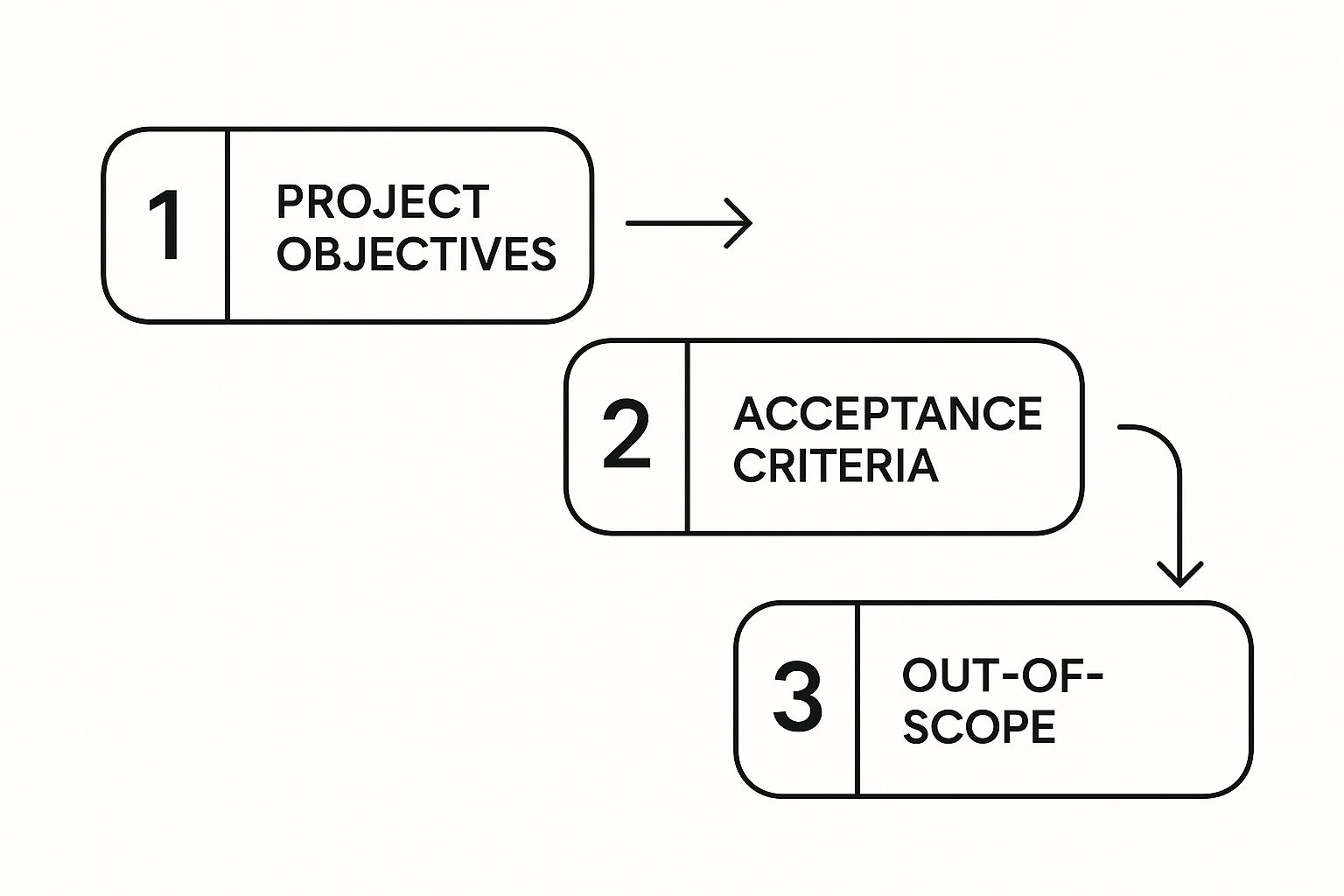Defining your project scope is really about drawing a line in the sand. It’s where you meticulously list out the project's specific goals, what you’ll deliver, all the tasks involved, the costs, and when it’s all due. Think of it as creating a clear boundary that separates what the project will achieve from what it won’t. This single document becomes the roadmap for the entire team, preventing confusion and keeping those sneaky, uncontrolled changes at bay.
Why a Clear Project Scope Is Your Greatest Asset

Before we jump into the "how," let's get real about the "why." A vague or poorly defined scope is one of the top reasons projects go off the rails. It’s the fast track to blown budgets, missed deadlines, and a team that’s completely burned out.
Don’t think of the project scope as just some bureaucratic paperwork. It's the foundational agreement that protects your project from chaos and gets everyone pointing in the same direction.
When the scope is fuzzy, expectations get tangled. The marketing team might be picturing a slick promotional video as part of a website launch, but the dev team thinks they’re done the second the site goes live. That kind of disconnect creates friction, forces rework, and eats away at trust. A solid scope nips all that ambiguity in the bud.
The Power of Setting Boundaries
At its core, defining the project scope is about setting clear, agreed-upon boundaries. You’re documenting exactly what you’re building and what you’re not. This is a game-changer for project managers trying to assign tasks, schedule the work, and budget everything correctly. TechTarget actually has some great insights on the components of a scope statement if you want to dig deeper.
This foundational document does a few critical jobs:
- Manages Stakeholder Expectations: It gets clients, team members, and leadership all on the same page about what the final result will be. No surprises.
- Prevents Scope Creep: This is your defense against the dreaded "can you just add…" requests. It gives you a baseline to measure any new ideas against, stopping the project from ballooning out of control.
- Guides Decision-Making: When a new idea or challenge pops up, the scope statement is your guidepost. Does it align with our core objectives? If not, it can wait.
- Enables Accurate Planning: Once the scope is locked in, you can create much more accurate timelines, figure out who you need on the team, and set a budget that isn’t just a wild guess.
To make this crystal clear, let's break down what goes into a solid project scope.
The Core Components of Project Scope
This table sums up the essential elements that every comprehensive project scope should define. Think of these as the non-negotiables.
| Component | What It Defines |
|---|---|
| Deliverables | The tangible outcomes or products the project will produce (e.g., a new website, a report). |
| Objectives | The specific, measurable goals the project aims to achieve. |
| Tasks | The work activities required to produce the deliverables. |
| Exclusions | What is explicitly not part of the project. This is crucial for avoiding misunderstandings. |
| Constraints | Limitations or restrictions, like budget, time, or resources. |
| Assumptions | Factors believed to be true for planning purposes but that carry some risk. |
Nailing these components gives you a robust framework that can stand up to the pressures and uncertainties of any project.
Ultimately, a strong project scope is your best defense against the common pitfalls that derail otherwise great ideas. It’s the difference between a project that feels chaotic and one that moves forward with purpose and clarity.
Without it, you can’t even begin to figure out what success looks like. If you're wondering about that next step, we have a whole guide on how to measure project success. Just remember, getting the scope right is the first—and most important—piece of that puzzle.
Uncovering What Stakeholders Truly Need

A rock-solid scope is built on one thing: understanding what people actually need, not just what they say they want. This is where you have to roll up your sleeves, move past the simple Q&A, and really dig into the problems you’re trying to solve.
I’ve seen it happen too many times—a team skips this part and builds a beautiful feature that absolutely no one uses. It’s a direct path to a failed project.
The goal here is to turn those vague, hand-wavy requests into concrete, actionable requirements. It's a methodical process that starts with collecting insights from everyone involved—clients, end-users, even regulators—to get a crystal-clear picture of what "done" looks like. It's this initial discovery that stops you from making dangerous assumptions down the road.
Moving Beyond Surface-Level Requests
It’s all too easy to take an initial request at face value. Imagine the sales team asks for a "better reporting dashboard." A weak scope would just list "new dashboard" as a deliverable and call it a day. A strong scope starts by asking why.
You need to put on your detective hat.
Probe deeper. Get to the core of the issue with questions that force clarity:
- What specific decisions will this new dashboard help you make?
- What data are you currently missing that’s blocking those decisions?
- Can you walk me through how you gather this information right now?
Suddenly, the conversation shifts from a simple feature request to a real business problem. Maybe they don’t need a whole new dashboard at all. Maybe all they need is a better way to filter the reports they already have. You won’t know until you ask.
Proven Techniques for Gathering Requirements
Relying on a single email thread or one big meeting to gather requirements is a recipe for disaster. I've learned that the best approach uses a mix of techniques to paint the full picture.
The most dangerous assumption in project management is thinking you know what your stakeholders really want. Your job is to facilitate the discovery process and guide them toward a clear, shared vision.
Try blending a few of these methods to see what works for your project:
- Structured Interviews: One-on-one conversations are gold. They let you dive into an individual’s specific pain points and priorities without the noise and influence of a group setting.
- Collaborative Workshops: Get stakeholders from different departments in the same room. Use techniques like brainstorming or user story mapping to build consensus and see how different needs intersect. You’d be surprised by the "aha!" moments that come out of these sessions.
- Observation: This one is powerful. Actually watch users interact with an old system or go about their daily tasks. What people do is often way more revealing than what they say they do.
By combining these approaches, you end up with a much richer set of data. This solid foundation is crucial, and our guide on how to write project requirements can help you document everything you find. This ensures the scope you ultimately define is based on verified needs, not just someone’s initial guess.
Writing a Scope Statement That Leaves No Doubt
Okay, you’ve done the legwork and gathered all those stakeholder requirements. Now what? It's time to translate all that great insight into your project's constitution: a formal project scope statement.
This isn't just another document to check off a list. It’s the single source of truth for your project, drawing a clear line in the sand to eliminate any "I thought we were…" conversations down the road. Think of it as the official agreement your team and stakeholders sign off on before anyone writes a line of code or designs a single pixel.
A great way to get your thoughts organized before drafting the final statement is by using a solid project briefing template. It helps structure all the moving parts into a coherent starting point.
Core Elements of a Bulletproof Scope Statement
Your scope statement needs to be rock-solid—specific, measurable, and crystal clear. While the exact layout might change from project to project, there are a few non-negotiable pieces every effective statement needs to have. No wiggle room, no misinterpretations.
These components all fit together to give everyone a complete 360-degree view of the project. This infographic breaks down how you move from high-level goals to the nitty-gritty details.

As you can see, it all starts with the "why" (the objectives) before you can properly define the "what" (the deliverables) and, just as importantly, the "what we're not doing."
Defining What's In and What's Out
I can't stress this enough: a great scope statement is defined just as much by what it excludes as what it includes. Explicitly calling out what is out of scope is your number one defense against the dreaded scope creep.
Let's make this real. Imagine a website redesign project. The objectives are clear: increase traffic by 20% and generate 10% more leads. The deliverables are a redesigned website and a new CMS. Easy enough.
But the exclusions are where you save yourself future headaches. You might explicitly state, "Mobile app development for iOS or Android is not included." This is crucial, especially when you're working with a tight $50,000 budget and a three-month deadline. Clarity here is everything.
To build your own, make sure you nail these sections:
- Project Objectives: What actual business outcomes will this project deliver? Make them SMART (Specific, Measurable, Achievable, Relevant, Time-bound).
- Deliverables: This is your list of tangible outputs. It could be a new software feature, a full-scale marketing campaign, or a technical research report.
- Acceptance Criteria: How will everyone agree a deliverable is finished and successful? Define the exact standards it has to meet.
- Exclusions: Be direct. List any related tasks, features, or deliverables that will not be part of this project. This prevents misunderstandings later.
- Constraints & Assumptions: Note any limitations (like budget, tech stack, or team availability) and list any assumptions you're making that could derail the project if they turn out to be wrong.
A scope statement isn’t just a formality; it’s a communication tool. Its main job is to ensure that when you say "the project is done," everyone agrees on what "done" actually means.
When you put all these pieces together, you get a powerful document that acts as your north star. To see how this looks in the wild, check out this helpful sample project scope document. Getting this right protects your team, manages expectations, and frankly, sets your project up for a much smoother ride.
Breaking Down The Work With A WBS
Your scope statement tells you what you're building. The Work Breakdown Structure (WBS) shows you how you’re actually going to get there. It’s the tool that turns a big, intimidating project goal into a simple, visual roadmap of small, manageable tasks.
Think of it like a family tree for your project. At the very top, you have the final deliverable—the finished product. From there, each level down breaks that deliverable into smaller and smaller pieces until you're left with individual tasks that are easy to assign, track, and complete.
This whole process, called decomposition, is where the magic happens. It’s how you move from abstract goals to concrete actions, making sure no critical details are missed and everyone on the team knows exactly what they’re responsible for.
From Big Goals to Small Tasks
Let's say you're planning a big corporate event. The main goal, "Corporate Event," is way too massive to tackle all at once. A WBS is perfect for breaking it down into logical chunks.
You’d likely start with the major components, which become the first level of your WBS:
- Venue Logistics: Everything related to the physical location.
- Guest Experience: All the touchpoints that impact your attendees.
- Marketing & Promotion: The plan for getting the word out.
- Budget & Administration: The nuts and bolts of finance and oversight.
Each of those is still a pretty big job, so the breakdown continues. Under "Venue Logistics," you'd create another level with more specific tasks like "Secure a Venue," "Arrange Catering," and "Organize A/V Equipment." You keep going until you reach what we call work packages—the smallest, most manageable units of work that can be realistically assigned and estimated.
This diagram shows how a simple bicycle project gets broken down into smaller and smaller work packages.

This kind of visual breakdown makes the entire scope of work easy to see at a glance and shows exactly how every little task contributes to the final goal.
The Real Power of a WBS
Creating a WBS isn't just a box-ticking exercise; it’s a seriously powerful tool for bringing clarity and control to your project from start to finish. It gives everyone a shared understanding of the work ahead and creates a baseline for tracking progress.
The true value of a WBS lies in its ability to translate a high-level scope statement into an actionable plan. It prevents the "how are we actually going to do this?" panic by mapping out every step in advance.
When you break work into smaller pieces, you get much better at estimating the time and resources needed for each task. This granular view helps you build a more realistic project schedule and budget.
It also makes ownership crystal clear. Each work package can be assigned to a specific person or team, which kills any confusion over who is responsible for what. To see how this fits into the bigger picture, checking out a complete project scope example can show you how a WBS complements the other key documents.
Scope Statement vs Work Breakdown Structure
While they work hand-in-hand, the Scope Statement and the WBS serve very different functions. The scope statement defines the project's boundaries, while the WBS details all the work needed to get there.
| Element | Project Scope Statement | Work Breakdown Structure (WBS) |
|---|---|---|
| Purpose | Defines the "what" and "why" of the project. | Outlines the "how" by detailing all the work. |
| Format | A narrative document. | A hierarchical, tree-like diagram. |
| Content | Includes objectives, deliverables, constraints, and assumptions. | Composed of deliverables broken down into work packages. |
| Focus | High-level project boundaries. | Detailed task-level execution plan. |
Ultimately, you need both for a well-defined project. The scope statement sets the destination, and the WBS provides the step-by-step map to get you there without getting lost.
How to Manage Scope and Control Changes
Defining your project scope is a huge milestone, but let’s be real—the work isn't over. Not even close. Now comes the ongoing battle to protect that beautifully crafted plan from the inevitable "just one more thing" requests.
A signed scope statement is your baseline, your source of truth. But the real test is how you handle those curveballs. Without a clear process, your perfectly defined project can quickly unravel into a chaotic mess of added features and shifting deadlines. The goal is to turn that potential chaos into a managed, transparent process.
Securing Formal Stakeholder Sign-Off
Before a single task kicks off, your first move should always be getting a formal sign-off on the scope statement from every key stakeholder. This isn't just a bureaucratic step; it’s about creating a unified front.
When everyone has officially agreed to the project’s boundaries, it becomes much harder for one person to push for changes that derail the whole plan. That signed document becomes your reference point for every conversation. When a new request pops up, you can always go back to it and ask, "How does this fit with what we all committed to?"
Establishing a Simple Change Control Process
Look, changes are going to happen. It's a project management reality. A new market opportunity might emerge, or a competitor might launch a feature you absolutely have to respond to. The goal isn't to prevent all change, but to control it.
Scope creep isn't caused by change itself, but by uncontrolled change. A lightweight, formal process is your best defense, turning unexpected requests into strategic decisions.
A simple change control process ensures every request gets properly evaluated instead of being casually approved in a hallway conversation. A basic process really just needs three parts:
- Submit a Formal Request: Anyone asking for a change needs to document it. This doesn't have to be complicated—a simple form outlining the request, the reason behind it, and the expected benefit is usually enough.
- Evaluate the Impact: This is your job as the project manager. You need to assess the true cost of the change. That means analyzing its impact on the project's timeline, budget, resources, and any new risks it might introduce.
- Approve or Reject: Based on your analysis, the key stakeholders either approve or reject the change. If it’s a go, the project plan, scope, and budget are formally updated to reflect the new reality.
This structured approach takes the emotion out of it and forces everyone to think about the trade-offs. We dive deeper into more strategies for controlling project scope in our detailed guide.
The Real Cost of Uncontrolled Change
Failing to manage scope isn’t a minor hiccup; it's one of the primary reasons projects go completely off the rails. The final, most critical piece of the puzzle is rigorously monitoring your progress and managing those change requests to avoid scope creep. It's a leading cause of cost overruns and schedule delays worldwide.
In fact, some research shows that around 52% of project failures are a direct result of poor scope management. You can see more on this from the project management experts at Global Knowledge. That number alone is why a disciplined approach to change control is simply non-negotiable if you want your project to succeed.
Questions That Always Come Up When Defining Scope
Look, even with the best plan in the world, defining project scope is where things get tricky. It's a constant balancing act, and you’re guaranteed to run into a few hurdles. Let's talk through some of the most common ones I see pop up on almost every project.
"What Do I Do When My Stakeholders Can't Agree?"
First of all, don't panic. This is completely normal. In fact, if your stakeholders don't have conflicting priorities at some point, I'd be a little suspicious.
You'll have the marketing director pushing for a launch date to sync with a huge campaign, while your lead engineer is adamant they need another month for QA. It happens all the time.
Your job isn’t to be the judge and jury; it's to be the facilitator. Get them in the same room (virtual or otherwise) and pull the conversation back to the project's real goals. The best way to do this is by framing it around trade-offs.
- "If we hit marketing's deadline, we're taking on a higher risk of post-launch bugs. Is the business okay with that trade-off to support the campaign?"
- "If we give engineering the extra month, we miss the campaign window entirely. What's the real business impact of that delay?"
Suddenly, it's not about who "wins." It's about making a strategic business decision together. You force everyone to think about priorities and what level of risk is acceptable. Whatever you decide, write it down—the decision and the reason why. You'll thank yourself later.
"How Detailed Does the Scope Really Need to Be?"
Ah, the classic "how long is a piece of string?" question. The honest answer? It completely depends on how you're running the project.
If you’re in a traditional Waterfall world, you need to get granular. Really granular. The whole point is to define everything upfront because making changes down the line is a nightmare of change requests and budget approvals.
But if you're working in an Agile environment, you can breathe a little.
For Agile, you focus on the big picture—the vision, the high-level goals, and the most important known requirements. You don't map out every single task for the next six months. Instead, you build a product backlog, which is just a prioritized wish list of features and user stories. The scope for your next two-week sprint is defined in painstaking detail, but anything beyond that stays flexible.
The goal is to have just enough detail to give the team clear direction for the immediate future, without locking yourself in and losing the ability to adapt. For Agile, a solid vision and a prioritized backlog are your north stars.
"So, How Is Scoping Different in Agile?"
This is a big one. Scoping in Agile isn't something you do once and then file away. It’s an ongoing conversation. Instead of one massive, unchangeable scope document, you manage it dynamically through the product backlog. The project's vision keeps everyone pointed in the right direction, but the exact deliverables can—and should—evolve.
Ultimately, a well-defined project scope always includes clear terms about who's responsible for what and how you'll verify the work is complete. As explained in TechTarget's project management guide, this is fundamental for keeping things on track. In Agile, that often looks like a rock-solid "Definition of Done" for each task and a backlog that's constantly being refined.
The real difference is how you treat change. In traditional project management, change is the enemy. In Agile, change is just part of the process—it's welcomed, as long as it adds real value and the product owner prioritizes it. The total scope isn’t set in stone, but the time and budget for each sprint usually are. It’s the perfect blend of structure and freedom.
At Creativize, we know that a clear project definition is the launchpad for creative success. Whether you're a brand searching for that perfect creative expert or a professional ready to dive into your next big project, we connect the right people to make amazing things happen. Find your next creative partner today at https://creativize.net.

